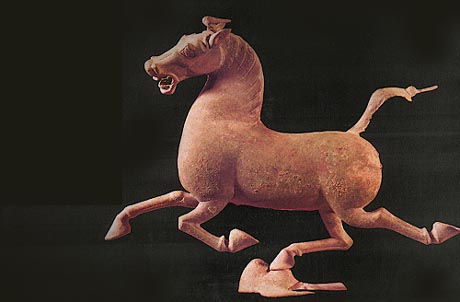You may remember that wonderful exhibition of the treasures of China at The Royal Academy. The highlights were the jade armour of some long-lost Oriental warrior, and a small bronze of a particularly elegant horse. It was 2,000 years old and had been dug up near Sian in 1969.
It has come to be known as The Flying Horse of Sian, and is remarkable for its depiction of energy, grace, and movement.

More remarkable is the story behind it, which explains why that ancient sculptor should have invested so much care on his model, for the flying horse was of critical importance to the ancient Chinese, and particularly so to Emperor Wu-Ti, whose capital Sian was.
Until the first century BC, the Chinese did not have proper horses. The imperial heartlands were not very well suited to raising them, being rather wet and given over to the production of rice.
The best they could offer was what we now call Przewalskis horse, a small, short-necked native of the central Asian highlands which we might regard as something of a cross between a mule and a zebra and which was actually extinct in the wild before its reintroduction quite recently.
It was adequate for load carrying but it must have been purgatory to ride, and, more importantly, it was hopeless as a cavalry horse. The Chinese also rode yaks, but these again were not exactly noted for their turn of foot.
This became a serious problem for the emperors when their territories started to be attacked by a warlike tribe from their north-west frontier, the fierce Hsiung Nu, now known as the Huns a splinter group of whom went on to colonise parts of Europe.
The Chinese built the Great Wall to keep the Huns out, but the problem that was that the enemy mounted his cavalry on fast, agile horses which ran rings around the Przewalski-borne Chinese.
It was not possible to defeat the Huns militarily until the Chinese could be similarly mounted, and Wu-Ti realised that he must get hold of some of the Huns heavenly horses, whom he knew came from somewhere on the Steppes.
Consequently, he despatched an emissary, an intrepid man called Chang, carrying an imperial yaks tail as a badge of office, to try to acquire allies among the tribes who lived beyond the Huns, and, most importantly, a breeding stock of horses.
Changs time along what is now known as the Silk Road was an adventure in its own right. He was captured by the Huns and imprisoned for 10 years, before finally escaping, still with his yaks tail. He returned to Sian three years later, without any horses, but with stories about the fabulous wealth of the Silk Road kingdoms, particularly Balkh (now Afghanistan) and Ferghana, in the Oxus valley.
He identified Ferghana as the source of these longed-for horses, and Wu-Ti subsequently mounted a military expedition to seize some. The inhabitants herded their horses into their cities on the Chinese approach, but eventually, after protracted negotiations, Wu-Ti returned with enough to start his own stock.
These were used to found the great stud farms of the Tang emperors in the north of the empire, that supplied the Chinese army. The Chinese also came to realise the importance of feeding their horses, and started to import alfalfa grass at roughly the same time.
The Chinese kept learning from the Huns, and by the sixth century were using their invention of stirrups. A relief on the tomb of the emperor who reigned from 627 to 649 AD shows a saddle clearly equipped with them.
They could never, however, fully match the Huns equestrian expertise, which ultimately enabled the golden horse to dominate large parts of Asia and Europe, and establish the Manchu dynasty in China.
Yet, had it not been for the heavenly horses from Ferghana, the great Chinese dynasties might never have been. Their speed and aptitude allowed the emperors to at least hold their own against the central Asian tribes for more than 1,000 years.
Little wonder that the sculptor of that magical bronze treated his subject with such care.



